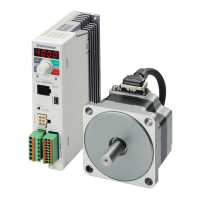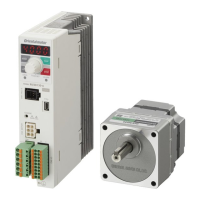9
•z
Round shaft type
Model
Distance from output shaft end
of motor and permissible radial
load [N (lb.)]
Permissible axial load
[N (lb.)]
10 mm
(0.39 in.)
20 mm
(0.79 in.)
BLE23
80 (18) 100 (22)
Not to exceed one-half the
motor’s mass
*
BLE46
110 (24) 130 (29)
BLE512
150 (33) 170 (38)
∗*
Minimize the axial load. If an axial load must be applied, do not let it
exceed one-half the motor’s mass.
Note
If the radial load or axial load exceeds the specied
allowable value, repeated load applications may cause the
bearing or output shaft of the motor, gearhead to undergo a
fatigue failure.
Installing the driver
The driver is designed so that heat is dissipated via air convection and
conduction through the enclosure. Install the driver to a at metal plate
oering excellent vibration resistance.
When two or more drivers are to be installed side by side, provide
20 mm (0.79 in.) and 25 mm (0.98 in.) clearances in the horizontal and
vertical directions, respectively.
Note
•
Install the driver in an enclosure whose pollution degree is 2
or better environment, or whose degree of protection is IP54
minimum.
•
Be sure to install the driver vertically (in vertical position).
Do not block the radiation openings.
•
Do not install any equipment that generates a large amount
of heat or noise near the driver.
•
If the ambient temperature of the driver exceeds 50 °C
(122 °F), revise the ventilation condition or force-cool the
area around the driver using a fan.
•z
Installing with screws
Install the driver vertically (in vertical position) and
secure the driver through the mounting holes using
two screws (M4: not supplied).
150 mm (5.91 in.)
•z
Mounting to DIN rail
Use a separately sold DIN rail mounting plate (model number:
PADP03
) and
attach it to a 35 mm (1.38 in.) wide DIN rail. After installation, x the both
sides of the driver with the end plate (not supplied).
DIN rail
DIN lever
Tab
Mounting screws (supplied)
Tightening torque: 0.3 to 0.4 N·m (2.6 to 3.5 lb-in)
Mounting holes
(M3, four locations)
Note
•
Do not use the mounting holes of the DIN rail mounting
plate for any purpose other than securing the DIN rail
mounting plate.
•
Be sure to use the supplied screws when securing the DIN
rail mounting plate. The use of screws that would penetrate
3 mm (0.12 in.) or more through the surface of the driver
may cause damage to the driver.
•z
Removing from DIN rail
Pull the DIN lever down until it locks using a at tip screwdriver, and lift the
bottom of the driver to remove it from the rail.
Use force of about 10 to 20 N (2.2 to 4.5 lb.) to pull the DIN lever to lock it.
Excessive force may damage the DIN lever.
Installing the external potentiometer (supplied)
Install the external potentiometer as shown below.
Nut
Tightening torque:
0.45 N·m (3.9 lb-in)
Set screw (M4)
Tightening torque:
0.4 N·m (3.5 lb-in)
• Reference mounting hole dimensions
[Unit: mm (in.)]
Ø3 (Ø0.12)
7.5±0.4 (0.30±0.02)
Dial
Toothed washer
Dial plate
Mounting plate
Insulation
sheet
Soldering the variable resister terminal and the lead wires
Cover a heat-shrinkable tube over the soldered part to insulate.
Soldering condition: 235 °C (455 °F), less than 5 sec.
Lead wire
Terminal
Heat-shrinkable tube
Solder (Pass the lead
wire through the terminal
hole and give it two or
three turns.)
Dial
Variable
resistor

